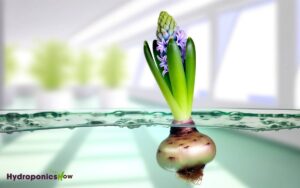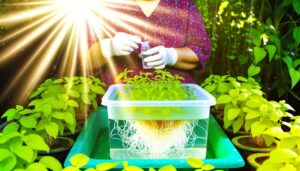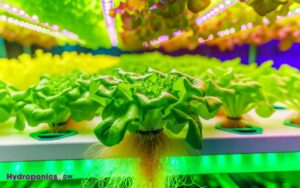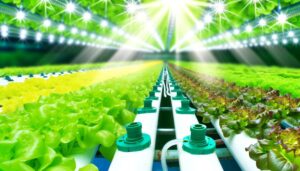Complete Guide to Plant Pechay in Hydroponics in 3 Steps
Planting pechay in hydroponics requires selecting an appropriate system such as NFT or DWC, using certified seeds with high germination rates, and setting up the system for ideal nutrient delivery and control. Pre-soak seeds for 6-8 hours, use sterile growing mediums, and maintain ideal pH (5.5-6.5) and temperature (20-25°C).
Transplant seedlings carefully, use balanced nutrient solutions, and guarantee proper light (14-16 hours/day) and temperature control. Monitoring pH and EC levels is essential for nutrient absorption and plant health.
This process, when meticulously followed, guarantees robust pechay growth and maximized yield potential. Further details enhance understanding and precision.
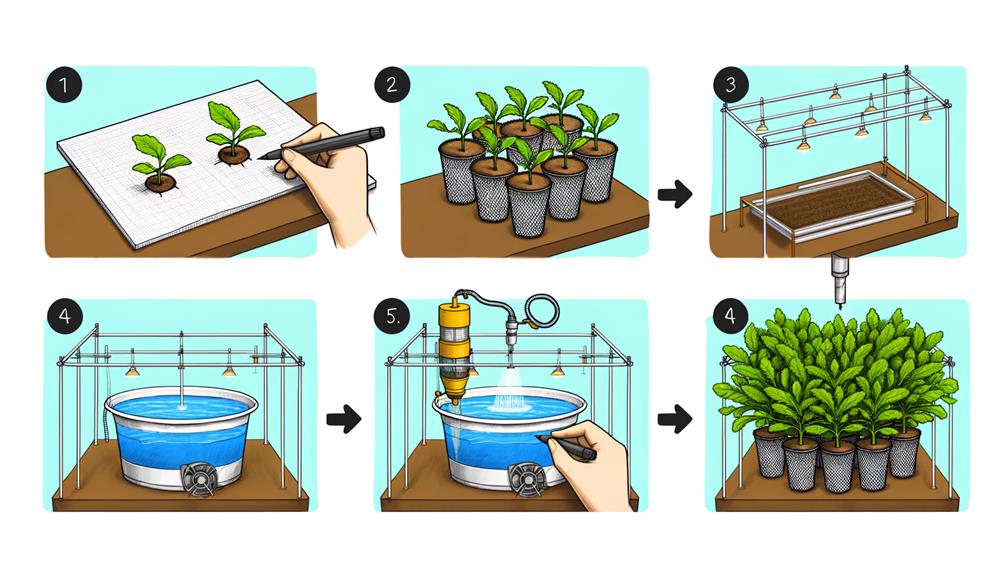
Key Takeaways
- Choose an NFT or DWC hydroponic system for simplicity and effective nutrient delivery.
- Use certified, disease-resistant pechay seeds with at least 85% germination rate.
- Pre-soak seeds and germinate in sterile mediums like rockwool or coconut coir.
- Maintain nutrient solution pH between 5.5 and 6.5 and EC between 1.5 and 2.5 mS/cm.
Selecting the Right Hydroponic System
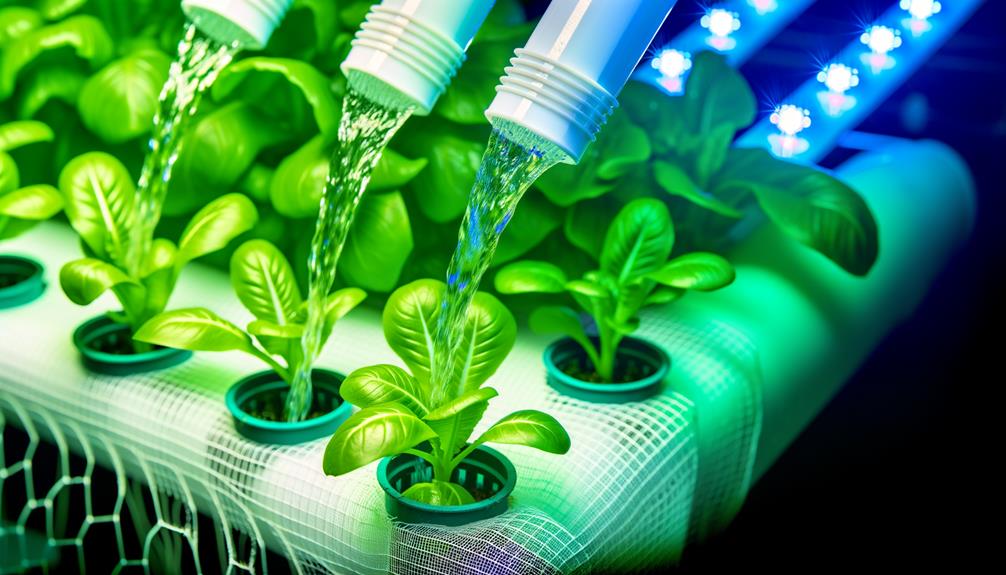
Choosing an appropriate hydroponic system for growing pechay involves evaluating various methods such as nutrient film technique (NFT), deep water culture (DWC), and aeroponics, each with distinct advantages and limitations.
NFT provides a continuous flow of nutrient solution over the roots, promoting ideal growth but requiring precise monitoring to prevent clogging.
DWC submerges roots in an oxygenated nutrient solution, ensuring robust nutrient uptake but necessitating vigilant oxygenation to avoid root rot.
Aeroponics, which mists roots with nutrient solution, offers superior oxygenation and nutrient delivery but demands complex infrastructure and high initial investment.
Analytical assessment of these systems reveals that factors such as resource availability, maintenance capacity, and budget constraints critically influence the selection of an ideal hydroponic system for pechay cultivation.
Choosing Quality Pechay Seeds
After selecting an appropriate hydroponic system, the next critical step involves procuring high-quality pechay seeds to guarantee ideal germination and growth rates. It is essential to choose seeds that are certified and tested for viability. High germination rates, disease resistance, and genetic purity are key indicators of quality. Additionally, consider the seed’s origin and supplier reputation to guarantee consistency.
| Criteria | Importance Level | Notes |
|---|---|---|
| Germination Rate | High | Guarantee at least 85% for best outcomes |
| Disease Resistance | High | Minimizes disease incidence in hydroponics |
| Genetic Purity | Medium | Maintains desired characteristics |
| Supplier Reputation | High | Trustworthy suppliers guarantee quality |
Quality seeds form the foundation for successful hydroponic pechay cultivation.
Setting Up Your Hydroponic System
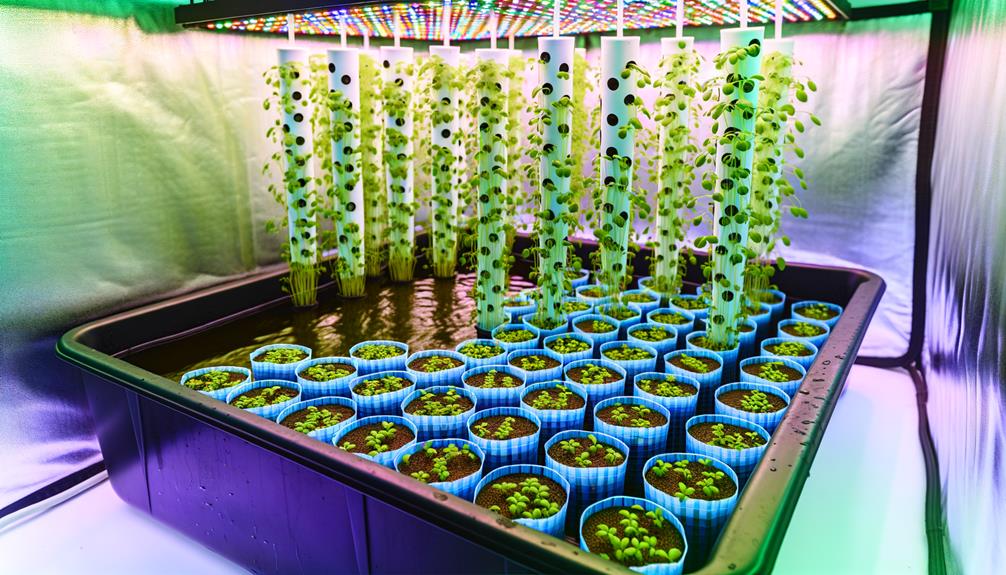
Establishing an efficient hydroponic system for pechay cultivation requires a thorough understanding of system types, nutrient solutions, and environmental controls.
Among the viable systems, Nutrient Film Technique (NFT) and Deep Water Culture (DWC) are often preferred for their simplicity and effectiveness. NFT systems utilize a thin film of nutrient solution that flows over the root zone, providing oxygen and nutrients, while DWC suspends roots in a nutrient-rich solution with continuous aeration.
Nutrient solutions should be precisely formulated, balancing essential macro and micronutrients. Environmental factors such as pH levels (ideally 5.5-6.5), temperature (18-24°C), and light (14-16 hours/day) must be meticulously regulated to optimize growth.
Properly calibrated systems guarantee robust pechay development and higher yields.
Germinating Pechay Seeds
With your hydroponic system in place, the next step involves germinating pechay seeds to secure a strong start for your crop.
Begin by selecting high-quality seeds, which are vital for best germination rates. Pre-soak seeds in water for 6-8 hours to soften the seed coat, enhancing water absorption.
Utilize a seedling tray filled with a sterile growing medium such as rockwool or coconut coir. Plant seeds approximately 0.5 cm deep and maintain consistent moisture by misting lightly.
Guarantee an ambient temperature of 25°C, which is perfect for pechay seed germination. Place the tray under a grow light with a photoperiod of 16 hours light and 8 hours dark.
Germination typically occurs within 4-7 days under these controlled conditions.
Transferring Seedlings to Hydroponics

Once the pechay seedlings have developed their first true leaves, they are ready to be transferred to the hydroponic system for continued growth.
Carefully remove the seedlings from their initial growing medium to minimize root disturbance. Rinse the roots gently to remove any residual soil, which can clog the hydroponic system.
Place the seedlings in net pots filled with an inert growing medium such as perlite or rockwool, guaranteeing the roots extend into the nutrient solution.
Secure the net pots in the hydroponic setup, optimizing spacing to prevent overcrowding and guarantee adequate light exposure and airflow.
Monitor the seedlings closely during this conversion phase, as they are particularly vulnerable to transplant shock and environmental stress.
Nutrient Solution Preparation
Proper preparation of the nutrient solution is fundamental to guaranteeing the ideal growth and health of the hydroponically grown pechay plants. The nutrient solution must be meticulously formulated to supply all essential macro and micronutrients, in precise concentrations, to support peak plant development.
Key components to take into account include:
- Balanced Macronutrients: Guarantee the solution contains nitrogen, phosphorus, and potassium in appropriate ratios.
- Micronutrient Inclusion: Incorporate essential micronutrients such as iron, manganese, zinc, and copper.
- Water Quality: Use distilled or reverse osmosis water to avoid contaminants.
- Solution Concentration: Follow recommended nutrient concentrations specific to pechay growth stages.
Accurate preparation of these components is critical to achieving successful hydroponic cultivation. By carefully measuring nutrient solutions and maintaining proper water pH levels, growers can optimize plant health and maximize yields. With the right approach and attention to detail, hydroponics made simple becomes a reality for both beginners and experienced cultivators alike.
Monitoring Ph and EC Levels
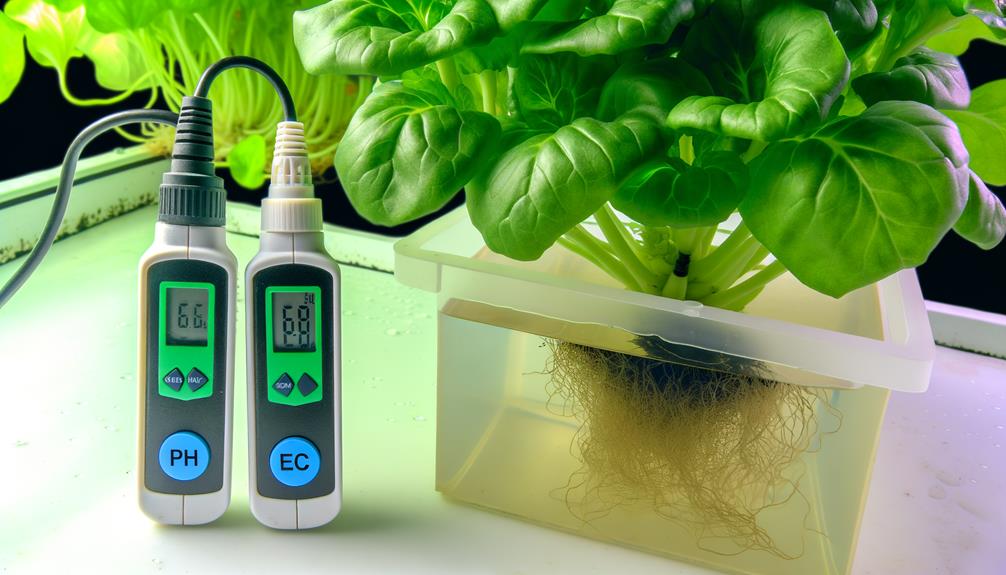
Monitoring pH and EC levels is vital for optimizing nutrient uptake and ensuring the health of pechay in a hydroponic system.
The ideal pH range for pechay is typically between 5.5 and 6.5, which can be accurately maintained using pH meters.
Electrical conductivity (EC) measurement tools are essential for evaluating nutrient concentration, enabling precise adjustments to nutrient levels as needed.
Ideal Ph Range
Maintaining an ideal pH range of 5.5 to 6.5 is essential for peak nutrient uptake in hydroponically-grown pechay, requiring regular monitoring of both pH and electrical conductivity (EC) levels.
The best pH guarantees that essential nutrients remain soluble and accessible to plant roots. pH levels outside this range can lead to nutrient lockout, impairing plant growth. Regular adjustments may be necessary to maintain stability, influenced by factors such as water quality and nutrient solution composition.
Key considerations include:
- Nutrient Absorption: Best pH maximizes nutrient solubility.
- Regular Testing: Frequent monitoring to detect deviations.
- Buffer Solutions: Use to stabilize pH fluctuations.
- Water Quality: Source water pH can affect overall system pH.
EC Measurement Tools
Accurate EC measurement tools, such as handheld meters and continuous monitoring systems, are indispensable for guaranteeing ideal nutrient levels in hydroponic pechay cultivation.
Electrical Conductivity (EC) quantifies the concentration of dissolved salts in the nutrient solution, crucial for optimal plant growth. Handheld meters offer portability and ease of use, providing immediate readings, while continuous monitoring systems enable real-time tracking and automated adjustments.
Studies indicate that maintaining an EC range between 1.5 to 2.0 mS/cm is optimal for pechay. Additionally, EC levels can fluctuate due to water evaporation and plant uptake, necessitating frequent monitoring.
Reliable EC measurement tools guarantee that nutrient solutions are consistently within the desired range, thereby enhancing growth rates and overall yield of pechay.
Adjusting Nutrient Levels
Guaranteeing ideal growth conditions for hydroponic pechay necessitates meticulous adjustment of nutrient levels, particularly through vigilant monitoring of pH and EC parameters.
pH levels should be maintained between 5.5 and 6.5 to optimize nutrient absorption.
Electrical Conductivity (EC) should be kept between 1.5 and 2.5 mS/cm to guarantee proper nutrient concentration.
Regularly calibrate your pH and EC meters for accurate readings.
Adjust pH using pH-up or pH-down solutions, and fine-tune EC by modifying nutrient solution concentration.
Consistent monitoring and adjustments will prevent nutrient imbalances and promote healthy growth.
- Maintain pH: 5.5-6.5
- EC range: 1.5-2.5 mS/cm
- Regular meter calibration
- Use pH-up or pH-down solutions
Light and Temperature Management
Effective light and temperature management are critical for maximizing the growth and yield of pechay in hydroponic systems.
Research indicates that pechay requires a minimum of 14-16 hours of light per day, utilizing full-spectrum LED lights to mimic natural sunlight.
Additionally, maintaining a temperature range between 18°C and 24°C is essential to guarantee ideal physiological responses and prevent thermal stress.
Optimal Light Conditions
Proper management of light and temperature is vital for maximizing the growth and yield of Pechay in a hydroponic system. Adequate light exposure is essential as it drives photosynthesis, which directly influences vegetative growth and overall plant health. Studies indicate that Pechay thrives under full-spectrum LED lights that mimic natural sunlight, providing consistent and high-intensity illumination.
Key points to take into account for ideal light conditions include:
- Light Duration: 14-16 hours of light per day.
- Light Intensity: 200-400 µmol/m²/s for ideal photosynthesis.
- Light Spectrum: Full-spectrum lights, particularly those rich in blue and red wavelengths.
- Distance from Light Source: 12-18 inches above the plant canopy.
Temperature Control Techniques
Maintaining ideal temperature levels is equally important as light management, with ideal temperatures for Pechay growth ranging between 20-25°C (68-77°F). Research indicates that temperatures beyond this range can stunt growth and reduce yield.
Implementing temperature control techniques such as using thermostats, heating mats, or cooling systems guarantees stability. For hydroponic systems, water temperature should also be monitored, ideally kept between 18-22°C (64-72°F). Excessive heat can lead to root diseases, while lower temperatures can inhibit nutrient uptake.
Integrating these controls with automated systems enhances precision, guaranteeing optimal conditions. Additionally, combining temperature control with adequate light management promotes robust growth, maximizing both photosynthesis and metabolic processes vital for Pechay development.
Harvesting Your Pechay
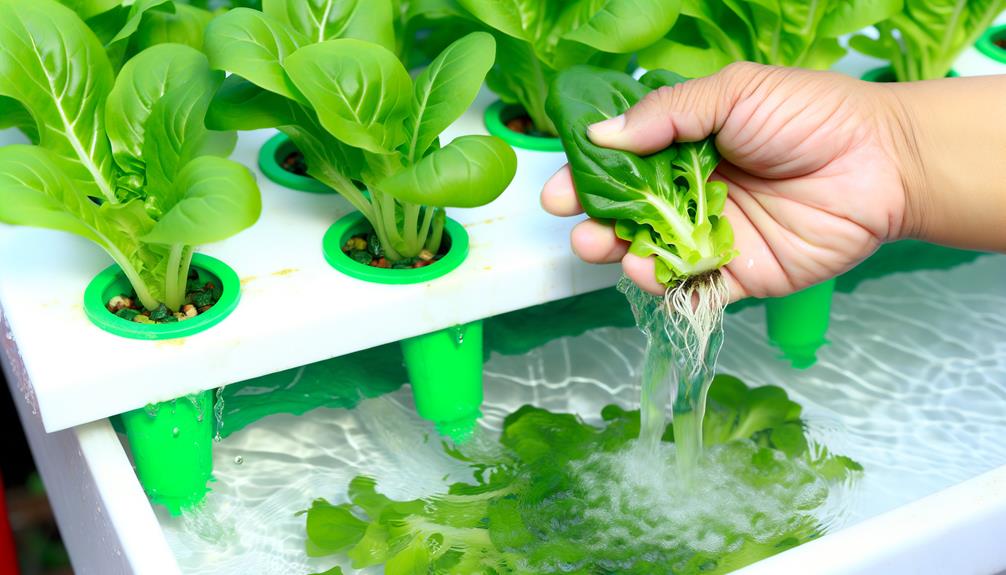
To harvest your pechay hydroponically, monitor the size and maturity of the leaves, typically ready for picking when they reach 6 to 8 inches in length. Proper timing guarantees ideal flavor and nutritional value.
Utilize sterilized tools to prevent contamination and carefully cut the leaves at the base.
- Ideal Harvest Time: Aim for 3 to 4 weeks post-germination.
- Nutrient Levels: Maintain balanced nutrient solutions to support leaf growth until harvest.
- Water Quality: Confirm pH levels remain between 5.5 and 6.5.
- Light Exposure: Provide 12-16 hours of light daily to enhance photosynthesis.
Conclusion
To summarize, the cultivation of pechay through hydroponic systems epitomizes the synergy between nature and technology.
By meticulously selecting quality seeds, establishing a robust hydroponic framework, and rigorously monitoring nutrient solutions and environmental conditions, one can achieve a bountiful harvest.
This method not only enhances yield but also optimizes resource efficiency, symbolizing a harmonious dance between precision and growth.
Such practices, rooted in evidence-based strategies, underscore the potential for innovative agricultural advancements.



